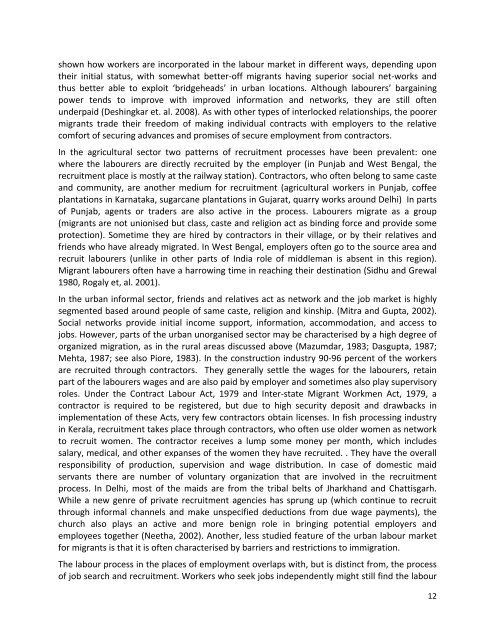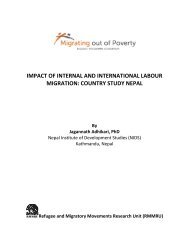workingpaper41 - Refugee and Migratory Movements Research Unit
workingpaper41 - Refugee and Migratory Movements Research Unit
workingpaper41 - Refugee and Migratory Movements Research Unit
Create successful ePaper yourself
Turn your PDF publications into a flip-book with our unique Google optimized e-Paper software.
shown how workers are incorporated in the labour market in different ways, depending upon<br />
their initial status, with somewhat better‐off migrants having superior social net‐works <strong>and</strong><br />
thus better able to exploit ‘bridgeheads’ in urban locations. Although labourers’ bargaining<br />
power tends to improve with improved information <strong>and</strong> networks, they are still often<br />
underpaid (Deshingkar et. al. 2008). As with other types of interlocked relationships, the poorer<br />
migrants trade their freedom of making individual contracts with employers to the relative<br />
comfort of securing advances <strong>and</strong> promises of secure employment from contractors.<br />
In the agricultural sector two patterns of recruitment processes have been prevalent: one<br />
where the labourers are directly recruited by the employer (in Punjab <strong>and</strong> West Bengal, the<br />
recruitment place is mostly at the railway station). Contractors, who often belong to same caste<br />
<strong>and</strong> community, are another medium for recruitment (agricultural workers in Punjab, coffee<br />
plantations in Karnataka, sugarcane plantations in Gujarat, quarry works around Delhi) In parts<br />
of Punjab, agents or traders are also active in the process. Labourers migrate as a group<br />
(migrants are not unionised but class, caste <strong>and</strong> religion act as binding force <strong>and</strong> provide some<br />
protection). Sometime they are hired by contractors in their village, or by their relatives <strong>and</strong><br />
friends who have already migrated. In West Bengal, employers often go to the source area <strong>and</strong><br />
recruit labourers (unlike in other parts of India role of middleman is absent in this region).<br />
Migrant labourers often have a harrowing time in reaching their destination (Sidhu <strong>and</strong> Grewal<br />
1980, Rogaly et, al. 2001).<br />
In the urban informal sector, friends <strong>and</strong> relatives act as network <strong>and</strong> the job market is highly<br />
segmented based around people of same caste, religion <strong>and</strong> kinship. (Mitra <strong>and</strong> Gupta, 2002).<br />
Social networks provide initial income support, information, accommodation, <strong>and</strong> access to<br />
jobs. However, parts of the urban unorganised sector may be characterised by a high degree of<br />
organized migration, as in the rural areas discussed above (Mazumdar, 1983; Dasgupta, 1987;<br />
Mehta, 1987; see also Piore, 1983). In the construction industry 90‐96 percent of the workers<br />
are recruited through contractors. They generally settle the wages for the labourers, retain<br />
part of the labourers wages <strong>and</strong> are also paid by employer <strong>and</strong> sometimes also play supervisory<br />
roles. Under the Contract Labour Act, 1979 <strong>and</strong> Inter‐state Migrant Workmen Act, 1979, a<br />
contractor is required to be registered, but due to high security deposit <strong>and</strong> drawbacks in<br />
implementation of these Acts, very few contractors obtain licenses. In fish processing industry<br />
in Kerala, recruitment takes place through contractors, who often use older women as network<br />
to recruit women. The contractor receives a lump some money per month, which includes<br />
salary, medical, <strong>and</strong> other expanses of the women they have recruited. . They have the overall<br />
responsibility of production, supervision <strong>and</strong> wage distribution. In case of domestic maid<br />
servants there are number of voluntary organization that are involved in the recruitment<br />
process. In Delhi, most of the maids are from the tribal belts of Jharkh<strong>and</strong> <strong>and</strong> Chattisgarh.<br />
While a new genre of private recruitment agencies has sprung up (which continue to recruit<br />
through informal channels <strong>and</strong> make unspecified deductions from due wage payments), the<br />
church also plays an active <strong>and</strong> more benign role in bringing potential employers <strong>and</strong><br />
employees together (Neetha, 2002). Another, less studied feature of the urban labour market<br />
for migrants is that it is often characterised by barriers <strong>and</strong> restrictions to immigration.<br />
The labour process in the places of employment overlaps with, but is distinct from, the process<br />
of job search <strong>and</strong> recruitment. Workers who seek jobs independently might still find the labour<br />
12



